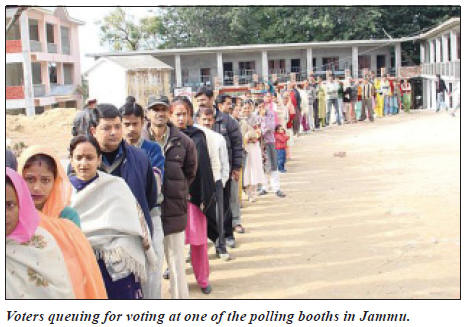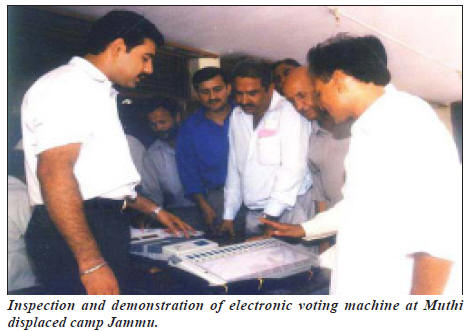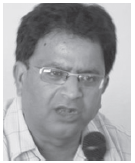Let Us
Not Learn Wrong Lessons
By Dr. Ajay Chrungoo
2008
elections are now over. A power shift has taken place. PDP-Congress alliance has been replaced in the state by
NC-Congress alliance. Chief Ministership of the state government has reverted
back to a Kashmiri for full six years, if the alliance lasts that long. All the
major portfolios like home, finance planning, revenue and power have been
retained by NC signifying the retrieval of the status quo of power.This status
quo had marginally changed during PDP-Congress alliance.

There are attempts to analyse
the assembly verdict in Jammu and Kashmir through the traditional 'secular'
prism and draw inferences which are either false or far fetched. The wrong
assessments will eventually effect the success or failure of the 'government'
which has been catapulted into power at a critical time when a stand off between
India and Pakistan is building in intensity.
UNDERSTANDING THE FAILURE OF BOYCOTT
The turnout of voters in this
election particularly in Kashmir valley has been phenomenal, more than 50% on an
average. It is invariably a big victory for electoral process in Kashmir Valley.
Many a eminent Kashmir analysts in New Delhi had prophecied that, "the
government will be lucky if they get more than 10 percent people to come out and
vote."
Out of all segments of people
living in Jammu and Kashmir only Kashmiri Pandits abstained from voting. Their
vote percentage was less than 10% and that too despite the fact that more than
43 Pandit candidates were in electoral fray and there was also no boycott call.
Both the factions of Hurriat
Conference campaigned for boycott of elections well before the onset of
elections. JKLF through its protracted 'Safar-e-Azadi' campaign focused
eventually on boycott of elections at the conclusion of its rallies and
interactions across the length and breadth of the Valley. Mirwaiz Omar Farooq
Chairman of All Party Hurriat Conference had declared with confidence that
'there will be 100 percent poll boycott' Ali Shah Geelani, to enlarge the appeal
of 'boycott slogan' even praised JKLF chief Yasin Malik and stated 'we want
boycott Safar-e-Azadi way'. The analysts who conclude that the 2008 elections
have been a decisive rebuff to separatists essentially underline the 'boycott
call' as the only indispensable strategy of separatists. The flexibility and the
deftness of the strategic interventions of Separatists in Kashmir Valley get
overlooked in this formulation. The separatists establishment does give
consideration to all such tactics which delegatimise the democratic process in
the state. But they have always valued deepening of its entrenchment in the
power structures within the state. Separatism in Valley has always considered
its reach and sway to influence and control the elected governments in the state
as its primary support structure perhaps as important as the support of
Pakistan. So delegitimising
elections by labelling them as rigged or coerced process or by campaigning for
boycott are not simple black and white imperatives which the separatists pursue.
They operate more in the grey area where they engage directly or indirectly into
the election process. They influence the election manifesto and party policies
of the political formations participating in elections. They influence the
selection of candidates. They throw up proxy candidates into the election fray.
The most essential objective which is pursued is not to allow any paradigm shift
in the state policy and ensure that subversive entrenchment is only deepened but
never eroded.
The entire spectrum of
separatist strategies has evolved over a period of time. Ali Shah Geelani got
himself elected to state assembly but relentlessly challenged Indian
constitutional position and debunked election process. Jamat-i-Islami potrayed
National Conference as its ideological rival in Kashmir and squarely blamed it
for accession of Jammu and Kashmir with India. The anti-Jamaat rivalry
manifested into streets when massive anti-Jamaat riots were lead by NC cadres.
But this rivalary was also not a black and while phenomenon. A symbiotic
relationship between NC and Jamaat particularly in the electoral sphere existed
right till 2002. Jamaat cadres would mobilise voters for NC and NC would
reciprocate by increasing Jamaat entrenchment in administration. Jamaat and
other separatist formations built the same symbiotic relationship with newly
formed PDP well before 2002 and has carried it right through the elections in
2008. There was, of course, a conflict of interests between separatists
formations including Jamat-i-Islami and PDP which had come into public domain in
last into years. Separatists visualised PDP as a usurper of its agenda. It
sensed encroachment on its space by none other than PDP. The stand off between
PDP and separatist formations would have continued but the terrorist attack in
Mumbai changed the Course of events in the Valley. Increased isolation of
Pakistan and pressures on separatist' feeder channel’s across made
Jamaat-i-Islami to change track. Mufti as per reports had been intensely
campaigning for their support.

It is difficult to comment as
to when exactly Jamaat decided to comeout whole hog in support of PDP but its
involvement in elections started manifesting right after the 1st phase of
elections. It built into a crescendo in the later phases. The top Jamaat leaders
were seen openly campaigning for PDP in Kulgam, Shopian, Pulwama as also
everywhere. Analysts read too much into the anti-election rhetoric of Ali Shah
Geelani but ignored the Traditional line of Jamaat-i-Islami which maintained
distance from boycott call and cautioned that in the prevailing political
scenario such a stance may prove 'counterproductive'. One thing is very clear
now. The separatist establishment intervened in election process not to boycott
as was their public stance but actually to increase the turnout of voters.
This assessment does not at
all indicate that even if separatists would have campaigned aggressiverly for
boycott they would have actually succeeded. In that eventuality voter turnout
would have been less but certainly an improvement over 2002 elections.
OTHER
FACTORS
The rural urban divide in
Valley and developmental issues were a dominant consideration for the people.
Sweeping inference is being drawn by some analysts in Delhi that the growth of
PDP in Valley is primarily the reflection of rural urban divide rather than
communal campaign. However many credible analysts have come out openly to record
that PDP campaign had a brazen communal character. Noted columnist Sh. Parveen
Swami states, "for the PDP, the returns from the incendiary communal campaign
it ran this summer, as well as its efforts to reach out to secessionists have
been disappointing." Immediately after the election results were declared Farooq
Abdullah openly accepted that PDP ran a campaign on 'Islamist agenda'. Many
residents of Kulgam area confided in their Pandit friends that Miss Mehbooba
Mufti was openly telling voters to choose between a 'school or a mosque'. "We
are for Mosque. If you choose a Mosque a school will automatically come. But not
the other way". PDP in its expositions has been identifying with Muslim causes
globally more than NC. It has sought to project 'Selfrule" document as more in
consonance with the movement of Pan-Islamism rather than Kashmiri Aspirations.
However, under playing of
rural urban divide as an important influence on the elections will be equally
incorrect. Rural-Urban divide has evolved in Kashmir Valley with the emergence
of a large rural middle class over the years. Emergence of Mufti Mohd Sayeed,
Late Abdul Gani Lone, Jamat-i-Islami and MuF reflects it more than anything
else. This time PDP made significant inroads into North Kashmir. PDP has won six
seats there while NC has done marginally better by winning seven seats. Central
Kashmir extending between Kangan and Ganderbal with Srinagar as its core has
been virtually swept by National Conference. However, PDP retained its
stranglehold on South Kashmir where it won 12 out of 16 seats. The better
performance of PDP is also a reflection of the urge of rural political class to
control political power.
This rural urban rivalary has
deepened over the years and now spilled into the public domain. Previously this
divide was subdued but now it has exploded into open. Reverberations of this
rivalary can be heard even after elections. Recently Sh. M.G. Hassan Mukhtar a
freelance journalists wrote in Kashmir Times that, "The original citizens of
Srinagar treat all villagers as second class irrespective of the language they
speak.If a villager goes to moon the urbanities would never digest it and rather
pull his legs...In reality the superiority complex (read inferiority complex of
foolishness) of urban fellows on the basis of nothing towards villagers is not a
good thing" In Srinagar this bitterness can be gauged by a cursory talk on
politics at a vegetable vendors shop or a burgers shop.
The increased developmental
process during PDP-Congress regime in rural areas has further heightened the
divide. Mufti used the Prime Minister's Gram Sadak Yojna to build extensive road
connectivity particularly in South Kashmir. Any village with a population of 500
or more was connected by a metalled road. A large portion of the 24,000 crore
special aid package to Kashmir was spend in the rural areas. Creation of
development authorities in Gulmarg, Tangmarg Pahalgam, Sonamarg and many other
places hastened the developmental process in rural areas which did translate
into political benefits for Mufti.

Mufti has not only used
predominantly the fundamentalist card and soft secessionist slogans, but also
the rural urban divide and developmental slogans to stabilise his party.
NC retained its previous
number of 28 in the assembly. PDP has increased its tally from 18 to 21. In 2008
elections there has been an overall swing of 5 percent in favour of PDP. It has
shown tendency to grow all over the Valley and has made dent in certain areas of
Jammu. The new Chief Minister Omar Abdullah has acknowledged this trend by
openly admitting, "the results definitely gave a fair idea that PDP is
making inroads everywhere in Valley. I think we need to take stock of it."
JAMMU
RESULTS
While belittling the communal
contours of PDP's rise the 'liberal' analysts infer a rise of communal stridency
in Jammu region. Which well-known columnists like Shankar Jha describe as
'historical' as if it is integral to the attitude of people living in Jammu.
Even a better informed journalist like Parveen Swami does not contest such
sweeping generalisations. His comments that," despite the apparently dramatic
improvement in BJP's fortunes-which have taken it from just one seat in 2002 to
11 now, Hindu Chauvinism hasn't yielded exceptional pay offs". The massive
support to Amar Nath Agitation in Jammu and hightened consciousness about the
systematic and organised discrimination meeted out to Jammu is an expression of
Hindu Chauvinism for even the unbiased 'liberal' intellectuals in rest of India.
This is perhaps an expression of a faulty vision which recognises concession to
the Muslim identity politics in J&K as a secular imperative. .
In Jammu province Congress
won 13 seats and BJP won 11 seats. There was almost a 3 percent negative swing
against Congress and a 10 percent swing in favour of BJP. BJP has been
runners-up in 13 seats and the number three in 7 constituencies in Jammu region
which means it has now decisively staked its claims for at least 30
constituencies in Jammu. But is the rise of BJP an outcome of communal
polarisation in the aftermath of Amarnath Agitation? Certain features of the
election outcome in Jammu have to be recognised to answer this question.
BJP candidates lost in most
of the constituencies where the intensity of Amarnath agitation was high. It
suffered defeat in Kathua, Billawar, Samba Vijaypur, Bishnah, Gandhi Nagar,
Chhamb, Akhnoor Udhampur, Chenani and Ramban. Mostly Congress candidates won
from these constituencies with one each going to National Conference and JK
National Panthers Party. Congress lost to BJP in those constituencies where
Amaranth Agitation was weak like Reasi, Basohli and Bani. The defeat of Shilipi
Verma the widow of Kuldeep Verma the martyr hero of Amarnath Agitation is
revealing. Also notable is the fact that those Congress candidates won who had a
better record as MLA's or ministers and who had also supported Amarnath
Agitation. Sham Lal Sharma from Akhnoor and Raman Bhalla from Gandhi Nagar are
the best examples to elucidate the fact. Almost all the Congress Ministers in
previous assembly lost this time. The best examples are that of Pt. Mangat Ram
Sharma and Gulchain Singh Charak. These ministers had not one come out openly in
favour of Amarnath agitation. Even the star campaigners of BJP like LK Advani,
Rajnath Singh, Narendra Modi, Arun Jaitely, Murli Manohar Joshi, Navjot Singh
Sidhu could not succeed in wooing voters against those Congress candidates who
had performed well as sitting MLAs and unambiguously identified with the
sentiment of Jammu.
SIDELIGHTS
Towards the end of this
analysis it will be pertinent to record some observations which have a value for
the future. Sakina Itoo won from South Kashmir against the tide of Islamists.
Mohd. Yusuf Tarigami of CPI(M) defeated his PDP rival for whom Jamat lead no
holds bar campaign. Mr. Tarigami of CPI(M) who at every opportunity has
supported separatists cause and undermined the exodus of Kashmiri Pandits seemed
trailing almost to the end of the counting process only to sail across after few
hundred Pandit votes caste in his favour where counted towards the end.
The Kashmiri Pandit votes
cast in small numbers showed preference in favour of NC where the main choice
was between NC and PDP. Dr Shafi of PDP won from Beerwah constituency by a mere
margin of 124 votes which included 80 votes from KP's. This may be an exception
because he was favoured not for his party affiliation and was considered a
better person having close relationship with the Pandits of his constituency.
Congress won 3 seats from
Kashmir Valley. Has done well in 5 more constituencies. It has at least a clear
demarcated chunk of 10 assembly seats to work for in the next elections.
CONCLUSION
'The 2008 mandate can
stabilise the situation if NC plays its cards well. After 2002 elections NC
adopted a policy line of mirroring or aping PDP line. It changed its policy on
Pakistan and terrorism hoping that it will steal a March ahead of PDP. At the
crunch time of elections fundamentalist establishment and Pakistan made a choice
in favour of PDP leaving it in lurch. Will NC ride the same ideological band
wagon?
Congress has survived on the
edge. Will it ignore its legislative base as it has done in the past and loose
its relevance in Jammu?
BJP enthused by the response
of people during the elections and hoping to win around twenty five seas threw
enough hints that it was ready to join hands with PDP or NC to come to
government. It has shown ready willing to dispense with its ideological baggage
for which it still has space in Jammu. Will it play the power game or the role
of an instrument to bring a fundamental change in power balance in favour of
Jammu?
CPI(M) has again survived a
sole presence in the present assembly from Kulgam constituency in Kashmir
Valley. Jamaat declared it as a party of ‘Kuffar’. People still voted it into
power in a stiff battle. Will CPI(M) still flirt with Muslim communalism and
separatism as it has done so far?
The future in J&K is pregnant
with possibilities both good or bad.
Source: Kashmir
Sentinel
| 
















No one has commented yet. Be the first!